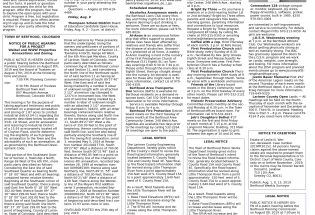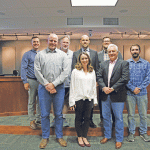New rule proposed for wolf reintroduction management plan
By Robin Ferruggia
The Surveyor
Colorado Parks and Wildlife (CPW) officials are in support of adding a rule to the final version of the Colorado Wolf Restoration and Management Plan that will allow federally-protected gray wolves to be shot and killed on sight under certain circumstances.
In order to apply Section 10(j) of the federal Endangered Species Act the wolves will be listed as a “nonessential experimental population.”
An “experimental population” is a group that is geographically isolated from other existing populations of the species. The designation allows the U.S. Fish and Wildlife Service (USFWS) to re-establish self-sustaining populations in regions outside of the species’ current range when doing so fosters the species conservation and recovery.
“Non-essential” means that the reintroduced species will contribute to restoring the species, but the recovery of the species can be achieved without the specific population involved.
“A 10(j) rule relaxes the prohibitions on take under the federal Endangered Species Act, and similar rules have been put in place for all wolf restoration efforts in the United States,” said Gary Skiba, an advisor for the Rocky Mountain Wolf Project, a retired wildlife biologist who worked with the state wildlife division and who currently serves as a wildlife manager for the San Juan Citizens Alliance. “Wolves would remain protected under the federal Endangered Species Act, and the proposed 10(j) rule would allow for the harassment and lethal take under very specific and limited circumstances. Those allowances ensure that livestock producers can protect their property from wolf depredation.”
The circumstances under which a wolf may be killed include when there is a history of confirmed wolf depredation on private land or public lands where someone has a grazing permit.
More specific details are available online at https://www.fws.gov/coloradowolf. Please see Table 2-2 beginning on pages 2-10.
“In these types of limited circumstances, the only way to prevent future depredation is through the removal of the wolf/wolves, and in some cases, the only practical way to do that is through lethal removal. It’s worth noting that based on experience in the Northern Rockies, fewer than 20% of wolves are ever involved in attacks on livestock,” said Skiba.
The decision to implement Section 10 resulted from a letter written by U.S. Senators John Hickenlooper and Michael Bennet. They requested approval to apply the rule from Deb Haaland, Secretary of the Interior, and U.S. Fish and Wildlife Service officials.
In their letter, dated Sept. 2. 2021, they expressed concerns that “the fluctuating listing status of the gray wolf has caused uncertainty” for CPW in their efforts to develop a management plan. “State authorities need the flexibility to relocate, tag, or manage wolf and livestock interactions to ensure a more favorable process for local stakeholders.” The implementation of Section 10 would enable CPW to have more flexibility in managing the reintroduction.
Several days ago they received approval, which opens the opportunity for a public comment period on the proposed plan.
Please note that public comments on Section 10 are not the same as public comments on the draft wolf reintroduction plan. The last day for public comments on the wolf reintroduction plan was Feb. 22. 2023.
Detailed information about the proposed plan can be found online at https://www.fws.gov/sites/default/files/documents/20230209_Proposed_Rule_CO_Wolf_10j_wDEIS.pdf
Information on how to comment may be found online at https://www.fws.gov/press-release/2023-02/public-invited-comment-draft-rule-deis-proposed-colorado-gray-wolf
The last day for public comments is April 18, 2023.
CPW is still committed to encouraging non-lethal wolf control as much as possible. To that end, they have partnered with Colorado State University’s Center for Human-Carnivore Coexistence (CHCC).
CHCC is working with CPW to help reduce conflict between people and predators, including providing scientific research from ecological and social scientists, educational materials for the public, and a funding program through the CSU Foundation to help livestock producers prevent depredation by wolves.
“Human populations are expanding, putting animals in an ever-shrinking space,” said Kevin Crooks, director of Colorado State University’s Center for Human-Carnivore Coexistence and professor of Fish, Wildlife and Conservation Biology. “It’s a growing challenge globally.
“Data from other states shows that wolves have a small impact on the livestock industry as a whole. What costs wolves impose are borne by livestock producers. Many won’t suffer any losses. But those losses can have a substantial economic and emotional impacts. Those are real impacts.”
CHCC’s Wolf Conflict Reduction Fund is one way they are helping livestock producers. They currently have funding available that livestock producers can apply for, and are also accepting donations from the public.
The funds will be used to help livestock producers in various ways, including purchasing fencing, flagging, scare devices, guardian dogs and provide range riders to patrol and scare wolves away from livestock.
CPW is also planning to increase compensation to ranchers for losses from wolf depredation.
“We are planning to increase the amount from $8,000 per animal to $15,000,” said Travis Duncan, public information officer for CPW.
In addition, up to $15,000 will be added for veterinary expenses, for a total of a maximum of $30,000 per individual animal.
Compensation may also include indirect losses, such as decreased conception rates, he said. “Guard dogs would essentially be covered.”
Compensation for the loss of horses is included because horses are considered livestock under Colorado state law.
“Helping ranchers helps wolves,” said Crooks.
To make donations to the Wolf Conflict Reduction Fund please go to advancing.colostate.edu/wolfconflictreduction/.
For educational information on wolves and wolf reintroduction please go to https://sites.warnercnr.colostate.edu/centerforhumancarnivorecoexistence/learn-more-wolves/.
- April, 27 2017

- September, 21 2017

Obituary – Debra “Debbie&...
It is with great sadness to announce the death of Debra "Debbie" Lee Cross (Fiore),...
- August, 02 2019

- March, 30 2017

Donald (Don) W. Crain: Jan. 3, 1945 –...
Donald Winfield Crain died at his home sometime Sunday...
- October, 19 2017

Obituary – Robert P. Starck
Robert P. Starck, 82, died Oct. 10, 2017,...
- December, 14 2018

German corporate lawyer turned horse ...
By Katie Harris The Surveyor It was 2 a.m. when the phone rang in Germany...

Unified basketball comes to Turner Middle School
Community News

Mike Grace says goodbye as Brett Wing joins town board
Community News
POLICEBLOTTER
Community News
Northern Water sets C-BT quota at 70% for 2024
Community News

Emotions run high during Revere Property hearing
Community News
Snowpack at 119% above normal
Community News

Karspeck to serve third term as Berthoud mayor
Community News
COMMUNITY CALENDAR:
Community Calendar – add an event
Homestead Fine Art Gallery First Fridays OPEN HOUSE
03 May 4:00 PM - 7:00 PM
Homestead Fine Art Gallery First Fridays OPEN HOUSE
07 Jun 4:00 PM - 7:00 PM
Homestead Fine Art Gallery First Fridays OPEN HOUSE
05 Jul 4:00 PM - 7:00 PM
Homestead Fine Art Gallery First Fridays OPEN HOUSE
02 Aug 4:00 PM - 7:00 PM
Homestead Fine Art Gallery First Fridays OPEN HOUSE
06 Sep 4:00 PM - 7:00 PM
Homestead Fine Art Gallery First Fridays OPEN HOUSE
04 Oct 4:00 PM - 7:00 PM

